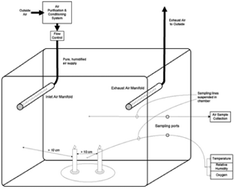A standard method for measuring benzene and formaldehyde emissions from candles in emission test chambers for human health risk assessment purposes
Abstract

* Corresponding authors
a
ToxMinds BVBA, Product Safety & Regulatory Affairs, 1200 Brussels, Belgium
E-mail:
thomas.petry@toxminds.com
Fax: +32 (0)2 762 91 46
Tel: +32 (0)2 762 91 45
b International Association for Soaps, Detergents and Maintenance Products (A.I.S.E.), 1160 Brussels, Belgium
c SC Johnson Ltd., Frimley, Surrey, UK
d Reckitt-Benckiser UK, Global Household Regulatory, Safety and Environmental Services, Dansom Lane, Hull, UK
e Procter & Gamble BIC, Product Safety & Regulatory Affairs, 1853 Strombeek-Bever, Belgium

 Please wait while we load your content...
Something went wrong. Try again?
Please wait while we load your content...
Something went wrong. Try again?
T. Petry, E. Cazelle, P. Lloyd, R. Mascarenhas and G. Stijntjes, Environ. Sci.: Processes Impacts, 2013, 15, 1369 DOI: 10.1039/C3EM00011G
To request permission to reproduce material from this article, please go to the Copyright Clearance Center request page.
If you are an author contributing to an RSC publication, you do not need to request permission provided correct acknowledgement is given.
If you are the author of this article, you do not need to request permission to reproduce figures and diagrams provided correct acknowledgement is given. If you want to reproduce the whole article in a third-party publication (excluding your thesis/dissertation for which permission is not required) please go to the Copyright Clearance Center request page.
Read more about how to correctly acknowledge RSC content.
 Fetching data from CrossRef.
Fetching data from CrossRef.
This may take some time to load.
Loading related content
